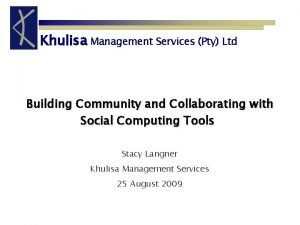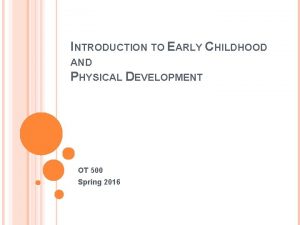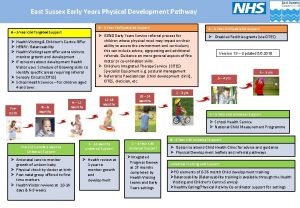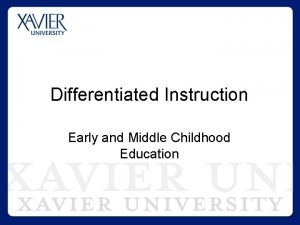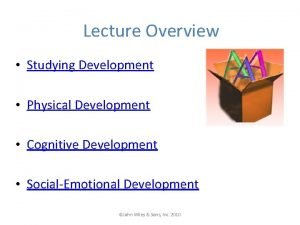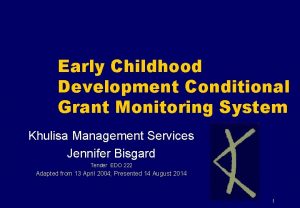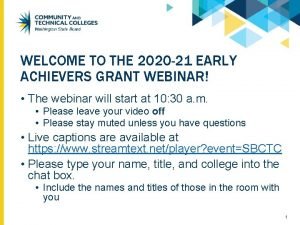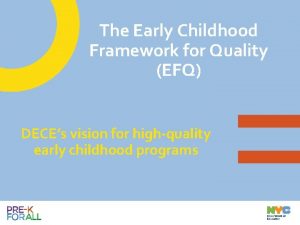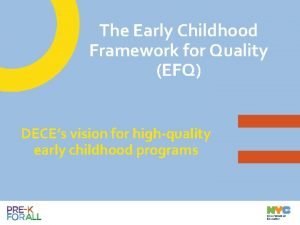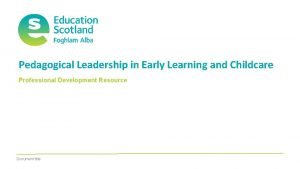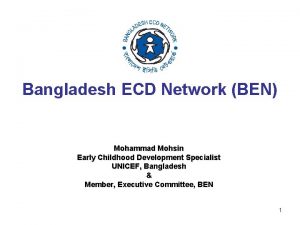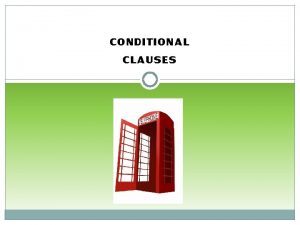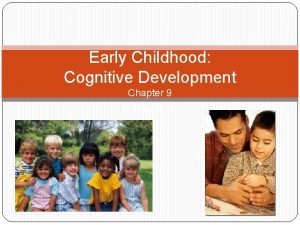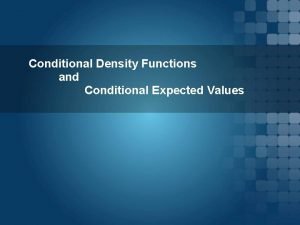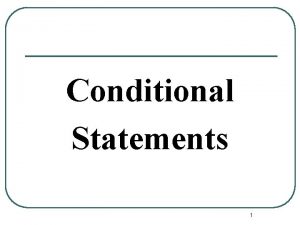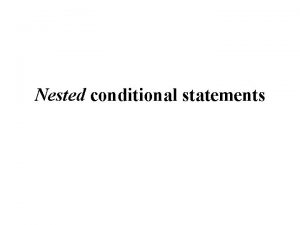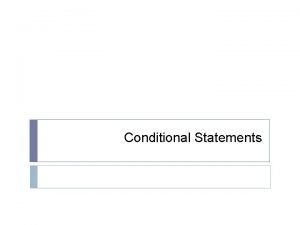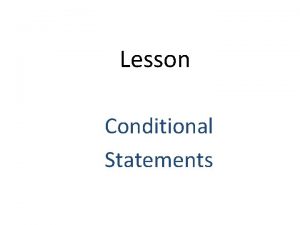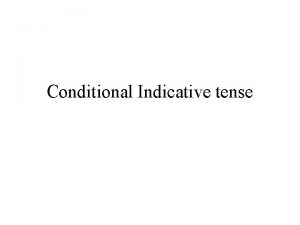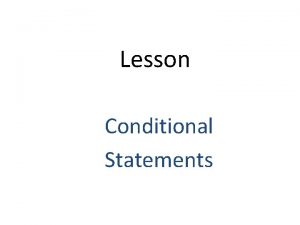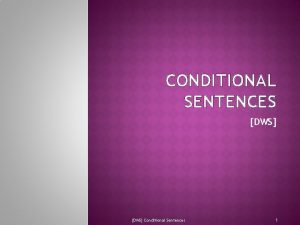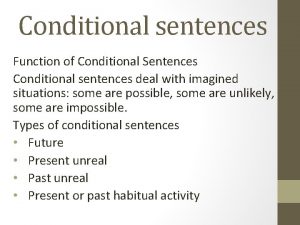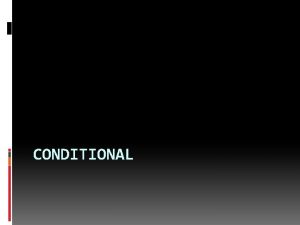Early Childhood Development Conditional Grant Monitoring System Khulisa






































- Slides: 38

Early Childhood Development Conditional Grant Monitoring System Khulisa Management Services Jennifer Bisgard Tender EDO 222 Adapted from 13 April 2004; Presented 14 August 2014 1

Provincial Implementation: Overview Conditional Grant: l Selected sites (target 4500); l Administered financial support in the form of subsidies / practitioner salaries; l Disbursed resource kits; l Created advocacy; and l Supported training practitioners. 2

Introduction: Background This report is a snapshot of implementation, not impact. 3

Introduction Training of Provincial and District Officials: Were provincial and district officials satisfied and did they show relevant learning following the Khulisa training programme? Implementation of Monitoring and Support Systems: How well has the monitoring and support systems been implemented? Provincial Conditional Grant Implementation: How effectively have the provinces delivered the conditional grant? 4

Introduction Conditional Grant Implementation: How has the conditional grant affected the sites? Advocacy Campaign Issues: What level of awareness do the officials involved in this project have of the advocacy campaign? Broader ECD issues: What are the findings related to the following broad ECD issues: l l l Social Development Registration? Grade R Learner Admission Policy? Social Grant Disbursement? Primary School Nutrition Programme? South African Council of Educators (SACE) Registration? 5

Caveat This is a monitoring not a research project from June 2003 to March 2004 Monitoring visits cannot be generalised to a province or to a district l Monitoring visits may have been (unconsciously or consciously) biased l Once most sites are monitored twice a year then the results will be more representative l 6

Reliability of Results Very reliable but slight deviations in the interpretation of findings occur. Officials sometimes feel “sorry” and inflate scoring so as “not to penalise” sites. Despite four quality control measures, inaccuracies still occur. 7

Training of Provincial & District Officials Were provincial and district officials satisfied with the training and did they show relevant learning following the Khulisa training programme? 8

Provincial Outcomes To set up conditional grants monitoring and support systems To be able to hold staff accountable for the monitoring and support process To ensure use of monitoring and support system on all Grade R sites To be able to train staff in the monitoring and support process Unit 1 – General Overview of the Monitoring and Support System Unit 2 – Monitoring and Evaluation Unit 3 - Support Unit 4 – Quality Control Unit 5 – Logistical Planning Unit 6 – Training Officials in your Province To be able to analyse and write up the data into quarterly monitoring reports Data Analysis and Report writing workshops 9

Training of Officials: District Outcomes To be able to plan and conduct monitoring of conditional grants and other Grade R sites Unit 1 – General Overview of the Monitoring and Support System Unit 2 – Monitoring and Evaluation To be able to provide support which results in the performance of sites improving Unit 3 - Support To be able to quality assure monitoring data Unit 4 – Quality Control Unit 5 – Logistical Planning 10

Kirkpatrick Training Evaluation Model 11

Training of Officials: Summary Findings Were provincial and district officials satisfied and did they show relevant learning following the Khulisa training programme? l l High degree of satisfaction with the training process (level one). Evidence of learning – both theoretical and practical (level two). Most participants had good attitude but when attitude was negative, evidence that the attitude improved (level two). Completed forms and the participation rates indicate levels three and four partially achieved Not all provinces are equal in their performance but some embraced the monitoring system enthusiastically. 12

Implementation of the Monitoring & Support System How well has the monitoring and support system been implemented? 13

Productivity: Officials Monitoring Average sites monitored per official 6. 4: l LP officials most productive (10. 7 visits) l NC least productive l One Mpumalanga official with 64 sites! Low average of 6 visits over 8 months, raises questions about the support model 14

No. of Sites Monitored Possible Sites Nr. visited at % Visited least once Nr visited twice % Visited twice or more EC 841 223 26. 5% 10 1. 2% FS 290 174 60. 0% 43 14. 8% GP 558 390 69. 9% 88 15. 8% KZN 1035 229 22. 1% 15 1. 4% LP 711 358 50. 4% 14 2. 0% MP 341 186 54. 5% 21 6. 2% NC 172 127 73. 8% 8 4. 7% NW 170 63 37. 1% 2 1. 2% WC 439 223 50. 8% 13 3. 0% 4557 1973 43. 3% 214 4. 7% Total 15

System Implementation: Officials’ Comments Greater sense of structure / focus: “I didn’t know what to do when I get to the ECD site but ever since I was trained on how to monitor and quality control… I don’t have problems. ” Opportunities: “I have learned that there is a team working together to improve the standard of ECD in our province. ” Improved quality of site visits: “Our school visits are much more focussed. ” Improvement at the sites: “I can see the differences at the sites after the visits and they have been improved. ” 16

System Implementation: Officials’ Comments Positive attitude: “My attitude towards site practitioners has totally changed. The amount of effort they put in managing those sites and the eagerness to learn from mistakes made [impressed me]. ” “I have a different approach now when giving feedback to the educators that I am working with. ” Impact on their workload: “It has made some changes, although I feel I’m not doing justice to this monitoring process due to the overload of my work. ” 17

System Implementation: Officials’ Comments Work is easier: “It makes my work as specialist easier. I know exactly what I will do at a site and what I would like to achieve. ” Sense of purpose with this system: “It changed the way I work with sites because now there is a country-wide tool being used which assists with monitoring and which provides direction with regards to what is monitored. ” 18

Provincial Conditional Grant Implementation How effectively have the provinces delivered the conditional grant? 19

Provincial Implementation: Summary Findings How effectively have the provinces delivered the conditional grant? Target: 4500 sites, 4396 supported l Of those 2/3 rds received subsidy on time 2600 received the kits, but 48% could show them Since Khulisa was not given the training database, no report on the RPL or training process 20

Level of Implementation at Conditional Grant Sites How has the conditional grant affected the sites? 21

Implementation Level: Introduction Sites categorisation “red”/ requires extensive assistance, l “yellow” requires support, l “green” requires less support and l “purple” / outstanding Progress data based on the 214 sites that were visited twice. l 22

Implementation Level: Finance & Admin 23

Implementation Level: Finance & Admin Potential support strategies: Provide templates, exemplars and guidance; l Identify practical management tips; l Motivate use of good financial and administrative records; l Champion ECD issues; and l Promote Social Development registration. l 24

Implementation Level: Healthy Development 25

Implementation Level: Healthy Development Possible support: l Identify and communicate areas where support is required with practitioner; l Encourage sites to register with Social Development; l Supply resources; and l Provide Knowledge / Skill Support. 26

Implementation Level: HIV/AIDS 27

Implementation Level: HIV/AIDS Possible support strategies: l Raise HIV/AIDS awareness; l Provide information regarding how to deal with HIV/AIDS at site level (blood injuries, orphaned children, nutrition); l Supply first aid training and resources (including cheaper substitutes); l Work with other stakeholders to build referral and support networks. 28

Implementation Level: Active Learning 29

Implementation Level: Active Learning Support strategies Build awareness and active learning skills; l Hold Training tenderer accountable through monitoring system; l Focus on follow up and reinforce training (partly through accessing Training database); l Minimise contradictive messages (Training tenderer vs. province); l Promote “communities of practice”. l 30

Implementation Level: Training 31

Implementation Level: Overall Performance Category Nr. of sites % Total Strong (Purple) 475 24% Average (Green) 1143 58% 338 17% 17 1% 1973 100% Needs support (Yellow) Needs intensive support (Red) Total sites 32

Implementation Level: Progress Province Improved Same Weakened Nr. of Sites EC 60% 0% 40% 10 FS 70% 0% 30% 43 GP 68% 1% 31% 88 KZN 47% 0% 53% 15 LP 57% 0% 43% 14 MP 43% 0% 57% 21 NC 50% 0% 50% 8 NW 50% 0% 50% 2 WC 69% 0% 31% 13 Total 63% 0% 37% 214 *Note: Only 214 sites were visited more than once 33

Broader ECD issues What are the findings related to the following broad ECD issues: Social development registration Grade R Learner Admission Policy Social Grant Disbursement Primary School Nutrition Programme SACE Registration 34

Soc. Dev. Registration Not Registered Conditionally Registered Fully Registered EC % 25. 9% 13. 7% 60. 4% FS % 3. 8% 92. 4% 3. 8% GP % 27. 6% 31. 0% 41. 4% KZN % 32. 4% 8. 8% 58. 8% LP % 59. 7% 13. 2% 27. 1% MP % 42. 3% 37. 1% 20. 6% NC % 37. 0% 21. 9% 41. 1% NW % 25. 9% 46. 6% 27. 6% WC % 25. 0% 53. 7% 21. 3% Total % 34. 2% 31. 8% 34. 0% *Note: Only sites that were indicated to be community based are included in this table. About 43 of the sites did not provide any information on this aspect. 35

Child Support Grants Unaware Aware Total Province Receiving Grants Not Receiving Grants EC 31% 69% 100% EC 14. 8% 85. 2% FS 27% 73% 100% FS 27. 3% 72. 7% GP 50% 100% GP 26. 5% 73. 5% KZN 29% 71% 100% KZN 12. 9% 87. 1% LP 18% 82% 100% LP 19. 5% 80. 5% MP 19% 81% 100% MP 48. 3% 51. 7% NC 16% 84% 100% NC 22. 7% 77. 3% NW 15% 85% 100% NW 27. 1% 72. 9% WC 67% 33% 100% WC 22. 7% 77. 3% Total 33% 67% 100% Total 24. 3% 75. 7% * Note: 112 Sites did not provide information on this aspect. *Note: This table only contains responses for practitioners that indicated that they were aware about social grants disbursement. 36

Broader ECD Issues: Summary Findings What are the findings related to the following broad ECD issues: Social Development Registration: Required for community-based sites, a third of the sites monitored are not even conditionally registered Grade R Learner Admission Policy: In 13. 3% Grade R classes, practitioners admitted to over-age learners 37

Broader ECD Issues: Summary Findings Social Grant Disbursement: Practitioners’ pastoral role is increasingly important due to HIV/AIDS, but 1/3 do not know if their learners are receiving their social grants Primary School Nutrition Programme: According to practitioners, only 59% of school-based sites are actually receiving PSNP food/support SACE Registration: Only 13% Grade R teachers are registered 38
 Proximodistal development
Proximodistal development Khulisa management services
Khulisa management services Fine motor skills development in early childhood
Fine motor skills development in early childhood Physical development in early childhood
Physical development in early childhood Psychosocial development in early childhood
Psychosocial development in early childhood Language development in early childhood
Language development in early childhood A vygotskian classroom promotes ________.
A vygotskian classroom promotes ________. What is biosocial development in early childhood
What is biosocial development in early childhood Early childhood development with differentiated instruction
Early childhood development with differentiated instruction Development
Development Early warning intervention and monitoring system
Early warning intervention and monitoring system Ecd conditional grant
Ecd conditional grant Early achievers grant
Early achievers grant Three types of early childhood programs
Three types of early childhood programs Types of early childhood programs activity a chapter 2
Types of early childhood programs activity a chapter 2 E f q
E f q Efq
Efq Pdp early childhood education and training program
Pdp early childhood education and training program How to welcome parents in orientation
How to welcome parents in orientation Nsw department of education
Nsw department of education Leonardo da vinci's childhood
Leonardo da vinci's childhood Trends in early childhood education
Trends in early childhood education Early childhood research quarterly author guidelines
Early childhood research quarterly author guidelines Early childhood ireland garda vetting
Early childhood ireland garda vetting Chapter 7 early childhood ages 3 through 5 answer key
Chapter 7 early childhood ages 3 through 5 answer key Kerlavage stages of artistic development
Kerlavage stages of artistic development Amelia earhart facts about her childhood
Amelia earhart facts about her childhood Pakistan alliance for early childhood
Pakistan alliance for early childhood Pedagogical leadership skills
Pedagogical leadership skills Isaac newton early childhood
Isaac newton early childhood Eminem early childhood
Eminem early childhood Ece in pakistan
Ece in pakistan Early childhood education in bangladesh
Early childhood education in bangladesh Bellfort ecc
Bellfort ecc Associates in early childhood education jobs
Associates in early childhood education jobs Brownsburg early childhood center
Brownsburg early childhood center Attainment targets barbados
Attainment targets barbados Early childhood education
Early childhood education Kentucky governor's office of early childhood
Kentucky governor's office of early childhood

